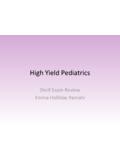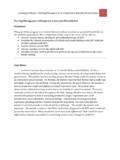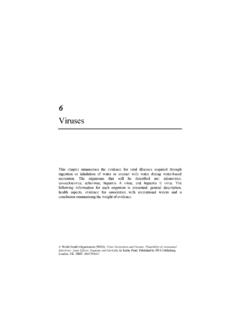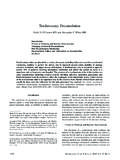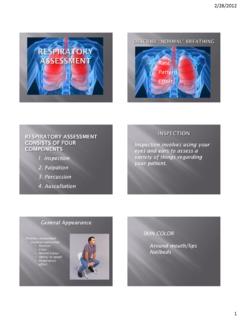Transcription of High Yield Internal Medicine - Long School of …
1 high Yield Internal MedicineShelf Exam ReviewEmma Holliday RamahiCardiologyA patient comes in with chest Best 1sttest = EKG If 2mm ST elevation or new LBBB (wide, flat QRS) STEMI ST elevation immediately, T wave inversion 6hrs-years, Q waves last forever Emergency reperfusion-go to cathlab or *thrombolyticsif no contraindications Right ventricular infarct-Sxsare hypotension, tachycardia, clear lungs, JVD, and NO pulsusparadoxus. DON T give nitro. Txw/ vigorous fluid resuscitation. Anterior LADV1-V4 LateralCircumflexI, avL, V4-V6 InferiorRCAII, III and aVFRventricularRCAV4 on R-sided EKG is 100% specific Next best test = cardiac enzymes If elevated NSTEMI. Check enzymes q8hrs x 3. Txw/ morphine, oxygen, nitrates, aspirin/clopidogrel, and b-blocker Do CORONARY ANGIOGRAPHY w/in 48hrs to determine need for intervention.
2 PCI w/ stenting is standard. CABG if: L main dz, 3 vessel dz(2 vessel dz+ DM), >70% occlusion, pain despite maximum medical tx, or post-infarction angina Discharge meds = aspirin (+ clopidogrelfor 9-12mo if stent placed) B-blocker ACE-inhibitor if CHF or LV-dysfxn Statin Short acting nitratesMyoglobinRises 1stPeaks in 2hrs, nlby24 CKMBRise 4-8hrsPeaks 24 hrs, nlby 72hsTroponin IRise 3-5hrsPeaks24-48hrs, nlby 7-10days If no ST-elevation and normal cardiac enzymes Diagnosis is unstable angina. Work up- Exercise EKG: avoid b-blockers and CCB before. Can t do EKG stress test if old LBBB or baseline ST elevation or on Digoxin. Do Exercise Echo instead. If pt can t exercise-do chemical stress test w/ dobutamine or adenosine. MUGA is nuclear Medicine test that shows perfusion of areas of the heart. Avoid caffeine or theophyline before Positive if chest pain is reproduced, ST depression, or hypotension on to coronary angiographyPost-MI complications MC cause of death?
3 New systolic murmur 5-7 days s/p? Acute severe hypotension? step up in O2 concfrom RA RV? Persistent ST elevation ~1mo later + systolic MR murmur? Cannon A-waves ? 5-10wks later pleuriticCP, low grade temp?Arrhythmias. V-fibPapillary muscle ruptureVentricular free wall ruptureVentricular septal ruptureVentricular wall aneurysmAV-dissociation. Either V-fib or 3rddegree heart blockDressler s syndrome. (probably) autoimmune pericarditis. Tx w/ NSAIDs and aspirin. A young, healthy patient comes in with chest If worse w/ inspiration, better w/ leaning forwards, friction rub & diffuse ST elevation pericarditis If worse w/ palpation costochondriasis If vague w/ hxof viral infxnand murmur myocarditis If occurs at rest, worse at night, few CAD risk factors and migraine headaches, w/ transient ST elevation during episodes Prinzmetal sangina Dxw/ ergonovinestimtest.
4 Txw/ CCB or nitratesEKG Progressive, prolongation of the PR interval followed by a dropped beat Cannon-a waves on physical exam. regular P-P interval and regular R-R interval varrying PR interval with 3 or more morphologically distinct P waves in the same lead . Seen in an old person w/ chronic lung dz in pending respiratory Three or more consecutive beats w/ QRS <120ms @ a rate of >120bpm Short PR interval followed by QRS >120ms with a slurred initial deflection representing early ventricular activation via the bundle of Kent . Regular rhythm with a ventricular rate of 125-150 bpm and atrial rate of 250-300 bpm prolonged QT interval leading to undulating rotation of the QRS complex around the EKG baseline In a pt w/ low Mg and low K. Li or TCA Regular rhythm w/ a rate btwn 150-220bpm. Sudden onset of failure patient/crush injury/burn victim w/ peaked T-waves, widened QRS, short QT and prolonged PR.
5 Alternate beat variation in direction, amplitude and duration of the QRS complex in a patient w/ pulsus paradoxus, hypotension, distant heart sounds, JVD Undulating baseline, no p-waves appreciated, irregular R-R interval in a hyperthyroid pt, old pt w/ SOB/dizziness/palpitations w/ CHF or valve dzMurmur Buzzwords SEM cresc/decresc, louder w/ squatting, softer w/ valsalva. + parvuset tardus SEM louder w/ valsalva, softer w/ squatting or handgrip. Late systolic murmur w/ click louder w/ valsalvaand handgrip, softer w/ squatting Holosystolicmurmur radiates to axilla w/ LAEA ortic StenosisHOCMM itral Valve ProlapseMitral RegurgitationMore Murmurs Holosystolic murmur w/ late diastolic rumble in kiddos Continuous machine like murmur- Wide fixed and split S2- Rumbling diastolic murmur with an opening snap, LAE and A-fib Blowing diastolic murmur with widened pulse pressure and eponym parade.
6 VSDPDAASDM itral StenosisAortic RegurgitationA patient comes in with shortness of cardiac or pulmonary? If you suspect PE (history of cancer, surgery or lots of butt sitting) heparin! Check O2 sats give O2 if <90% If signs/sxsof pneumonia get a CXR If murmur present or history of CHF get echoto check ejection fraction For acute pulmonary edema give nitrates, lasixand morphine If young w/ sxsof CHF w/ prior hxof viral infx consider myocarditis(Coxsackie B). If pt is young and no cardiomegalyon CXR consider primary pHTN Right heart cathcan tell CHF from pulmonary HTN (how?)Right Heart CathCHF Systolic-decreased EF (<55%) Ischemic, dilated Viral, ETOH, cocaine, Chagas, Idiopathic Alcoholic dilated cardiomyopathy is reversible if you stop the booze. Diastolic-normal EF, heart can t fill HTN, amyloidosis, hemachromatosis Hemachromatosisrestrictive cardiomyopathy is reversible w/ phlebotomy.
7 Tx- ACE-I improve survival-prevent remodeling by aldo. B-blocker (metoprololand carveldilol) improve survival-prevent remodeling by epi/norepi Spironolactone-improves survival in NYHA class III and IV Furosemide-improves sxs(SOB, crackles, edema) Digoxin-decreases sxsand hospitalizations. NOT survivalPulmonologyCXR Opacification, consolidation, air bronchograms hyperlucent lung fields with flattened diaphragms heart > 50% AP diameter, cephalization, Kerly B lines & interstitial edema Cavity containing an air-fluid level Upper lobe cavitation, consolidation +/-hilar adenopathy Thickened peritracheal stripe and splayed carina bifurcation Pleural Effusions Pleural Effusions see fluid >1cm on latdecu thoracentesis! If transudative, likely CHF, nephrotic, cirrhotic If low pleural glucose? If high lymphocytes? If bloody?
8 If exudative, likely parapneumonic, cancer, etc. If complicated (+ gram or cx, pH < , glc< 60): Insert chest tube for drainage. Light s Criteria < 200 LDH eff/serum < eff/serum < ArthritisTuburculosisMalignant or Pulmonary EmbolusPulmonary Embolism high risk after surgery, long car ride, hypercoagulablestate (cancer, nephrotic) Sxs= pleuriticchest pain, hemoptysis, tachypneaDecrpO2, tachycardia. Random signs = right heart strain on EKG, sinus tach, decrvascular markings on CXR, wedge infarct, ABG w/ low CO2 and O2. If suspected, give heparin 1st! Then work up w/ V/Q scan, then spiral CT. Pulmonary angiography is gold standard. Txw/ heparin warfarin overlap. Use thrombolyticsif severe but NOT if s/p surgery or hemorrhagic stroke. Surgical thrombectomyif life threatening. IVC filter if contraindications to chronic coagulation.
9 Pathophys: inflammation impaired gas xchange, inflammediator release, hypoxemia Causes: Sepsis, gastric aspiration, trauma, low perfusion, pancreatitis. Diagnosis: ) PaO2/FiO2 < 200 (<300 means acute lung injury)2.) Bilateral alveolar infiltrates on CXR3.) PCWP is <18 (means pulmonary edema is non cardiogenic)mechanical ventilation w/ PEEPPFTsObstructiveRestrictiveExamplesAsthmaCOPDE mphysemaInterstitiallung dz(sarcoid, silicosis, obese, MG/ALS, phrenic nerve paralysis, scoliosisFVC <80% predicted <80% predictedFEV1 <80% predicted <80% predictedFEV1/FVC <80% predictedNormalTLC >120% predicted <80% predictedRV >120%predicted <80% predictedImproves >12% with bronchodilatorAsthma doesCOPDand Emphysema don t. NopeDLCO reducedReduced in Emphysema2/2 alveolar destruction. Reducedin ILD due to fibrosis thickening distanceCOPD Criteria for diagnosis?
10 Treatment? Indications to start O2? Criteria for exacerbation? Treatment for exacerbation? Best prognostic indicator? Shown to improve mortality? Why is our goal for SpO2 94-95% instead of 100%? Important vaccinations?Productive cough >3mo for >2 consecutive yrs1stline = ipratropium, tiotropium. 2ndBeta agonists. 3rdTheophyllinePaO2 <55 or SpO2<88%. If cor pulmonale, <59 Change in sputum, increasing dyspneaO2 to 90%, albuterol/ipratropium nebs, PO or IV corticosteroids, FQ or macrolide ABX, FEV11.) Quitting smoking (can decr rate of FEV1 decline2.) Continuous O2 therapy >18hrs/dayCOPDers are chronic CO2 retainers. Hypoxia is the only drive for respiration. Pneumococcus w/ a 5yr booster and yearly influenza vaccineYour COPD patient comes with a 6 week history of Clubbing in a COPDer = Hypertrophic OsteoarthropathyNext best get a CXRMost likely cause is underlying lung If pt has sxs twice a week and PFTs are normal?
